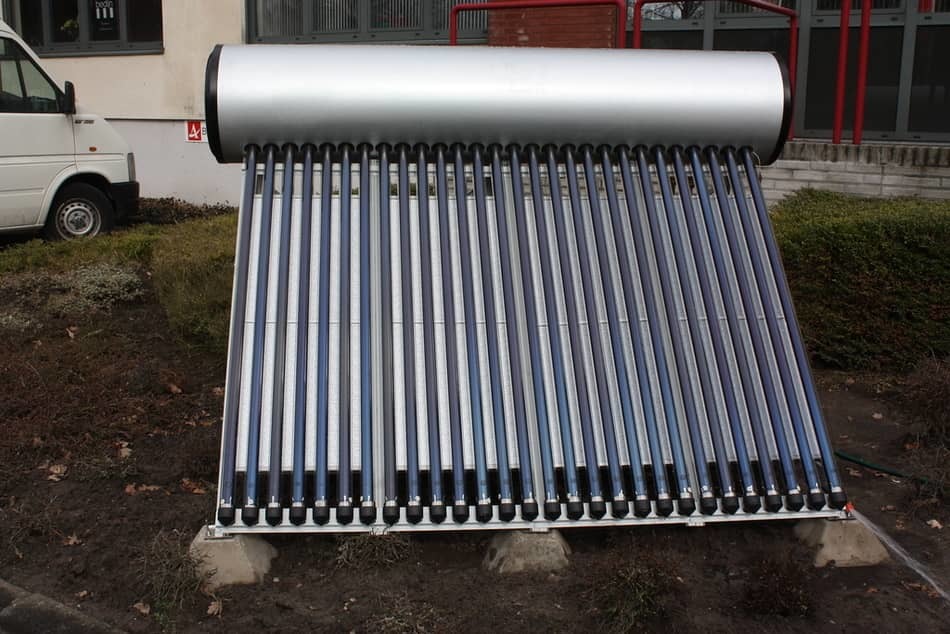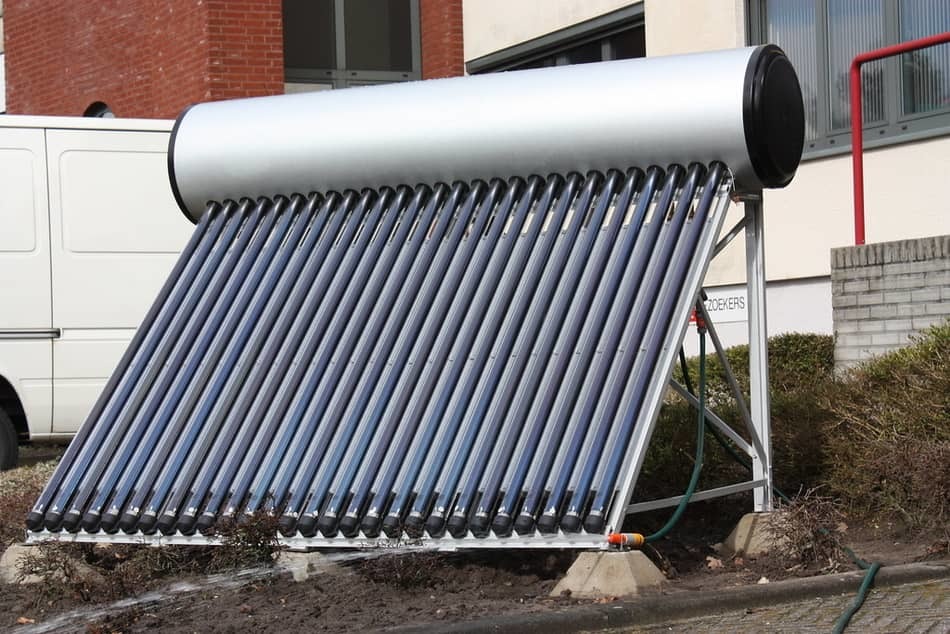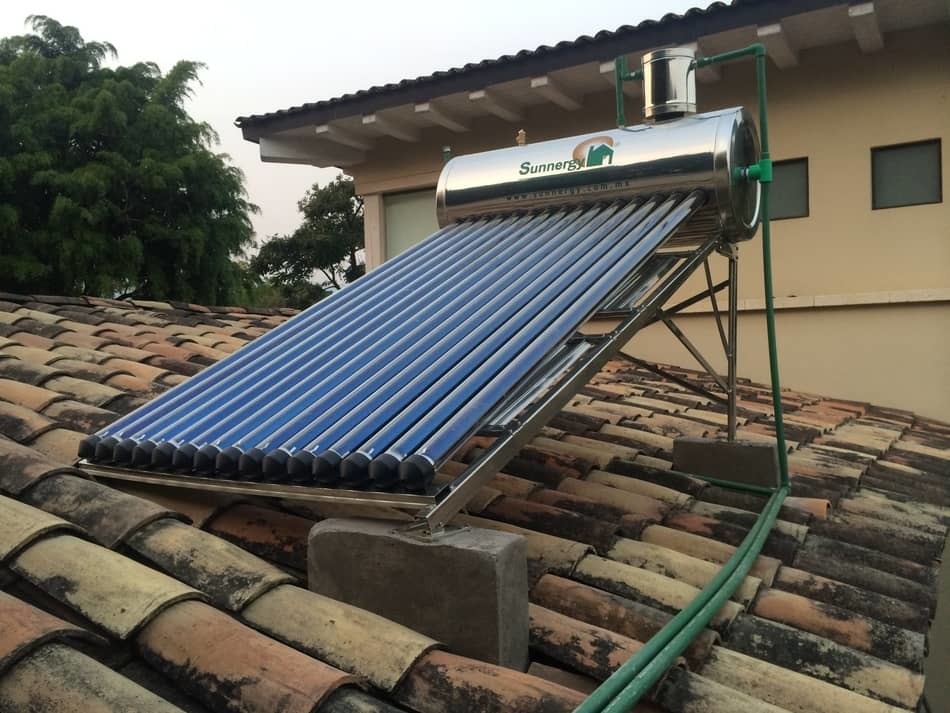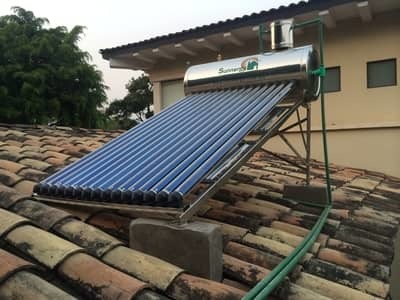Gardeners are always looking for new ways to heat their greenhouse, and one of the best ways is to use the sun. There are several options to use solar energy to heat your greenhouse.
Although solar-electric heaters are available, they’re incredibly inefficient, since they need to first convert solar energy to electricity, and then to heat. Better options for solar greenhouse heating are: thermal mass, solar hot water heating (hydronic heating), and heat exchangers.
Let’s dive in & take a look at the pros & cons for each option.
|
Heating method |
Pros |
Cons |
|---|---|---|
|
Hydronic heating (solar hot water) |
|
|
|
Photovoltaic (PV) solar panels |
|
|
|
Heat Exchanger |
|
|
Solar Hot-Water Panels
What are solar hot-water panels, and how do they work?
Using hot water to heat a greenhouse is a very common method for heating greenhouses.
Hydronic heating–also called solar hot-water heating–is energy efficient and healthy both for your greenhouse and the plants inside.
For solar hot-water heating, the sun warms water contained in panels, and then that water can then be heated further via a boiler.
A pump then circulates the hot water through tubes embedded in the greenhouse floor.
To further save resources, once the water is cooled it is returned and run through the cycle again.
How to setup and use solar hot water panels
A hydronic heating system can be quite difficult to set up, and is typically set up while the greenhouse is being built.
Unless you’re experienced and confident in setting up complex heating systems, the best way to install a hydronic system is to call in a plumber who’s experienced in hydronic heating systems.
Yep, this can get pricey–sometimes $10,000 – $20,000 or more, depending on the size of your greenhouse.
A hydronic heating system might require a boiling system to circulate the heated water properly.
This would, unfortunately, cost thousands of dollars and require a new setup for your greenhouse.
You’d have to place pipes under the floor in order to circulate the heat.
You could also hold water in barrels and use a simple pump to circulate water under a stone-tiled floor.
This option would be much cheaper and as effective, but would probably require more upkeep than getting it professionally done.
Benefits of using solar hot-water panels
Using solar hot water panels can be a great investment for your greenhouse.
Using water as a heating system is great for the planet and very energy efficient.
The water is heated using the energy of the sun, via solar hot-water panels, and then transferred to heat your greenhouse.
Once the water cools, it is recycled and used to heat your greenhouse all over again.
This can save you between 70-80% in heating costs, especially if you live in a colder climate and have to heat your greenhouse more often throughout the year.
Using hydronic heating a great solution to those who want to grow vegetables, but don’t live in a warm climate.
Heating bills can get expensive, and it’s impossible to actually grow plants outside when the weather can suddenly get cold.
Using hydronic heating saves on heating costs, and provides a stable temperature throughout the greenhouse.
Cost
The cost of a hydronic heating system depends on how big your greenhouse is.
Hydronic systems cost about $6.00 per square foot minimum, which can be compared at $8.00 per square foot with an electric heating system.
Hydronic systems MIGHT be less expensive than propane or forced-air furnaces, but it’ll depend on the size of your greenhouse, how sunny your climate is, and how well your greenhouse is insulated. There are a lot of factors to consider.
However, if you’re in a sunny climate, solar hot-water panels can be a good investment for heating your greenhouse.
Efficiency
Hydronic heating systems are very energy efficient.
They cost less than normal heating systems, and they are very good at keeping a temperature stable throughout a space.
Inside a greenhouse, plants often need a stable temperature in order to grow efficiently, and a hydronic heating system is the perfect solution.
In addition, the water is even recycled and used again and again to heat your greenhouse. This saves water, which is good both for the planet and your wallet.

Photovoltaic (PV) solar panels
What are PV solar panels?
PV solar panels are probably what you think of when you hear the word “solar panel”. These panels directly convert sunlight into electricity.
In order to heat your greenhouse, you’d then have to turn that electricity into heat for your greenhouse.
So, that 2-step conversion (sunlight-to-electricity, then electricity-to-heat) means that using PV panels to produce heat is incredibly inefficient.
That’s because you lose energy at each step.
How to use PV solar panels
It can be a bit difficult to properly set up PV solar panels for your greenhouse.
You wouldn’t be able to put them on top of your greenhouse because they would block the sunlight your plants need to grow.
To solve this problem, you can either set them up on the ground near your greenhouse, or on an adjacent building.
The panels would then need to be connected to a power grid to properly distribute heat to your greenhouse.
Depending on the size of your greenhouse, you’ll need to get a certain number of PV solar panels.
Typically, a PV solar panel system generates 10 to 35 kWh per square feet per year.
A greenhouse typically takes 1 kWh per square foot of energy every year.
A greenhouse that takes up 10,000 square feet of space will need 27 3 by 5 feet solar panels to provide the heat it needs.
That’s a lot of solar panels for a generally small space!
Benefits
Using PV solar panels, given their inefficiency at generating heat, is unlikely to save money on energy in the long run.
It can get quite pricey to heat a greenhouse all year, especially in those cold winter months.
However, PV panels can produce electricity, which you can use to run fans, pumps, lighting, and irrigation systems in your greenhouse.
Disadvantages
PV solar panels are actually quite inefficient when it comes to heating your greenhouse.
The energy from the sun is converted into electricity, which then needs to be converted into heat.
This multi-step process dramatically reduces the amount of energy you can harvest from the sun.
In order to properly supply your greenhouse with heat, you’d need to buy and set up a lot of panels. This is inconvenient because it takes up a lot of square footage.
This method also entirely depends on the sun.
And the sun isn’t always out. Cloudy days–which means less solar energy–are more common, especially during colder months.
If you’re worried about your plants getting too cold during days that the PV solar panels aren’t able to provide enough energy to properly heat your greenhouse, it’d be best to find an additional method to heat your greenhouse.
Heat Exchangers
What is a heat exchanger?
A heat exchanger takes stored heat and circulates it throughout the greenhouse when it gets cold.
Heat can actually be stored very easily in soil within your greenhouse.
The heat exchanger draws the heat to the soil or some other thermal mass during the day, and when the outside temperature cools down, the stored heat can be circulated to heat the greenhouse.
How to use a heat exchanger for your greenhouse
In order to use a heat exchanger, you’ll need to set up pipes underneath the ground connected to the heat exchanger.
During the day, the fan from the heat exchanger will draw hot hair from the greenhouse through these pipes.
This cools the greenhouse air, heating the soil and thus stores heat energy that can be used later, when the greenhouse actually needs it.
When the greenhouse needs to be heated, especially during colder months or at night, the heat exchanger system can draw heat back up from the soil, circulating warm air through the greenhouse.
This system is fairly easy to set up, and usually doesn’t require complicated professional setup.
Benefits
This is generally cheap system to heat your greenhouse.
All of the heat that’s used to heat the greenhouse comes from the sun.
Using natural energy is always the best, as it helps the planet along with your bank account.
You’ll still need electricity to run the fan that the heat exchanger uses.
However, a PV solar panel can provide the electricity needed to run the heat exchanger.
When compared to the hydronic solar hot-water heating method, a heat exchanger system is cheaper to install.
A heat exchanger only requires a fan and pipes, while a hydronic heating system might require a boiler.
Disadvantages
This method depends entirely on the sun.
If it’s a cloudy day, your plants could suffer later that night, since little heat would be stored during the cloudy day.
During colder months, the likelihood of multiple cloudy days is pretty high.
In order to ensure that your plants stay healthy, it’d be best to find a backup method to keep your plants warm.
Other methods to heat your greenhouse:
Thermal Mass
What is thermal mass?
Thermal mass is an inexpensive way to heat your greenhouse. It requires materials that store thermal energy, such as soil, water, stone, or paving bricks.
The heavy material captures heat during the day, then releases its stored heat at night.
How to use thermal mass
Using thermal mass is one of the easiest methods to heating your greenhouse.
Using water barrels, for instance, is a great way to heat use thermal heat to heat your greenhouse. Simply stack several large water barrels in direct sunlight.
During the day, the barrels will capture the sun’s heat energy.
During nighttime, the excess heat will be released from the water in the barrels and will heat the greenhouse.
A creative method of using thermal mass to heat a greenhouse would be to use fish tanks.
If you’re interested in raising fish as well as plants, it might be beneficial to place your fish tanks inside your greenhouse.
The water in the tanks will store heat during the day and release it at night. This benefits your greenhouse immensely and gives you the perfect place to put your fish.
You can also use a heat exchanger to take it one step further.
This will better circulate the heat when it’s released from the thermal mass.

Benefits of using thermal mass
Thermal mass is the easiest and the cheapest way to heat a greenhouse.
Often, it only takes materials that you’d already have available.
There’s no need to set up a complicated heating system and there’s no need to do any extra work.
It also doesn’t cost you anything extra when the utilities bill rolls around.
Thermal mass is also quite effective, especially when it comes to heating at night.
Water and soil store heat surprisingly well, and your plants will often be fine left overnight, even if the outdoor temperature drops below freezing.
Disadvantages of using thermal mass
There are, however, some disadvantages to using thermal mass as your sole method to heat a greenhouse.
Since there is no fan, the heat doesn’t always circulate evenly.
Some plants may get more heat than others and some plants might not even get enough.
This method also solely relies on the sun to work. If the sun is covered, the materials won’t be able to store heat for your plants to use later.
Propane and gas heaters
What are propane and gas heaters?
You can buy propane and gas heaters at any store, and they are usually simply plugged into the wall.
It’s a quick way to heat your greenhouse using electricity.
Yeah, these technically aren’t solar heaters–they’re more like supplemental heat if you’re using any of the above methods and the temperature drops for an extended period of time.
How efficient are propane and gas heaters?
Propane and gas heaters are quite efficient at heating a greenhouse, especially when you’re in a pinch.
They can be bought for around $100 at any hardware store and are fairly easy to install. Simply clear a space for them in your greenhouse and turn it on.
If you’re going to use this method, it’s extremely important to install some sort of vent system in your greenhouse.
Ventilation prevents carbon monoxide poisoning, so it’s very important you take this step seriously!
You can also apply caulk to any joints around doors and windows to keep as much heat in as possible.
This will save money on energy and improve the efficiency on using a propane heater.
This is not a natural way of heating your greenhouse, so it won’t be as cost effective as other methods I’ve talked about here.
However, this method is very useful when everything else fails and you know your plants will need that extra heat!
Space heaters
Using a space heater is another option to keep your greenhouse warm when you’re desperate.
They’re fairly cheap to buy and easy to install.
Simply clear a space inside the greenhouse and plug it in!
In addition, there’s no need for a vent system with this method, as there is zero risk of carbon monoxide poisoning–so long as the space heater is electric.
This method can be a bit pricey, however. Running a space heater can really rack up that utilities bill.
I remember I once used one for my room when it was really cold in December. The utilities bill that I got that month quickly made me unplug it and put on a sweater!
This is why it’s best to use this method as a backup system.
It’s better to use natural energy to heat your greenhouse year-round.

Related questions:
Do you need to heat a greenhouse in the winter?
If you live in a colder climate, it’s very important to heat your greenhouse in the winter. Most plants aren’t able to grow naturally when it’s always cold outside. The greenhouse is supposed to provide plants with the proper environment to grow, so it can’t be cold inside your greenhouse. Your plants will freeze and they definitely won’t make it through the winter.
How can I heat a small greenhouse without electricity?
There are many ways to heat a greenhouse without electricity. The best way to heat a greenhouse without electricity is by using thermal mass. This method is super simple and super cheap! Simply stack water barrels in a place that gets a lot of sunlight inside your greenhouse and let them absorb heat to be released later. If you don’t have any water barrels, you can do the same with a large compost pile, which generates heat through the process of decomposition.
How do you insulate a greenhouse for winter?
Insulating a greenhouse is important in order to store the heat from the sun during colder months and at night. Insulating a greenhouse is easy, and can be done using everyday materials. Bubble wrap is commonly used to insulate greenhouses. The bubble wrap keeps your greenhouse warm, and doesn’t block the sun. Simply staple the bubble wrap to the outside of your greenhouse, making sure to cover every inch of the surface. It’s a fairly easy and cheap method.


